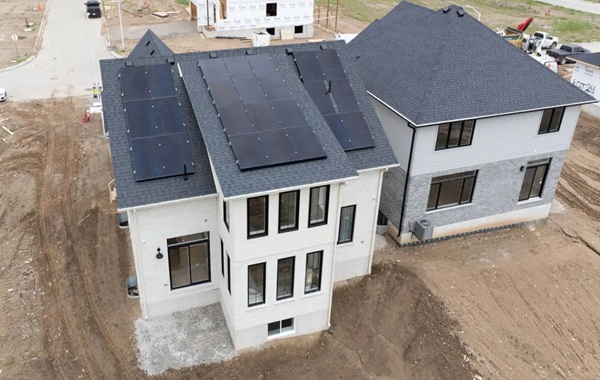Canadian engineers build self-powered solar home that cuts energy use by nearly half
A team of Canadian engineers on October 28 unveiled a fully electrified home in Komoka, Ontario, that could redefine how people power and heat their homes.
The project combines solar panels, a heat pump, and a thermal battery to create a system that eliminates fossil fuel use and dramatically reduces energy costs and emissions.
The researchers behind this innovation hope it will set the standard for net-zero housing worldwide.
A living lab for clean energy innovation
The project is led by Western Engineering and Ivey Business School professor Joshua Pearce and Ph.D. candidate Shafquat Rana, with contributions from mechanical and materials engineering chair Anthony Straatman, engineering professor Kamran Siddiqui, and Magnus Homes president Jaime Crncich.
Together, they designed an energy-efficient home system that uses locally produced solar energy to heat and power the house.
The two-story Komoka home is a real-world laboratory where the team collects and analyzes data. Early results are promising. The setup has cut electricity bills by 45% and lowered carbon emissions by 55%. The thermal battery, which stores heat using materials like salt or wax, helps increase solar energy use by 60%, reducing dependence on the grid.
“Solar costs have now undercut grid electricity costs, making solar a viable and desired option for most Canadians,” mentioned Pearce. “This project integrates solar panels, a heat pump, and a thermal battery to provide thermal energy for heating and supplying domestic hot water demand to the entire home.”
Efficient, scalable, and ready for real homes
The system’s efficiency comes from combining solar panels and a heat pump. The pump converts electricity generated from sunlight into heat, which is stored in the thermal battery for later use. This design makes the home four times more energy efficient than traditional systems.
“The goal is to prove the system’s effectiveness over one year, with the ultimate aim of eliminating the need for fossil fuels in home heating altogether,” stated Rana.
“Once validated, we want to expand this system to other homes across Canada, and eventually worldwide.”
Rana has equipped the home with sensors and smart wiring to measure performance and monitor energy use and costs. The data can be viewed in real time through a mobile app. Crncich, who lives in the experimental house, tracks energy creation and consumption daily.
“We have a unique opportunity to both create and consume the energy in our homes, and it’s really interesting to see, both as an owner and a builder, how those two balance,” Crncich said.
“I think many homeowners aren’t aware of their consumption, which is important for sustainability.”
A nearby home built by Crncich without the integrated solar and thermal system serves as a control model, allowing the researchers to directly compare results.
A pathway to affordable clean energy in Canada
While heat pumps and thermal batteries are gaining popularity in the U.S., they are relatively new to the Canadian housing market. This makes the system particularly valuable, as heating costs remain high nationwide.
“Many homes in Canada, unfortunately, are not even up to current code, let alone equipped with state-of-the-art photovoltaic technology,” said Pearce in the press release.
“Most people heat their homes with either natural gas or electric space heating, which is incredibly inefficient and hurts financially.”
Pearce added that using renewable energy for home heating safeguards against energy price hikes.
“If we can use renewable energy sources like solar power to provide electricity for our homes and then transfer that energy to a heat pump, for every one unit of electric energy, we get three units of heat, making them 300 percent efficient or more,” he added.
Building a sustainable future
For Rana, the project represents more than just comfort and cost savings. It’s a step toward addressing climate change.
“Climate change is real, and we need everyone to put even a small effort towards the fight,” noted Rana in the press release.
“Decarbonizing the residential sector is low-hanging fruit, which everyone can see. Integrating this sustainable setup in Canadian homes, especially new ones, can help us greatly reduce Canada’s carbon emissions to address the global impact of climate change.”
Source: Interesting Engineering
‘Impossible’ Life Found Beneath Arctic Ice Could Alter Climate Models
Canadian engineers build self-powered solar home that cuts energy use by nearly half/Canadian engineers build self-powered solar home that cuts energy use by nearly half

